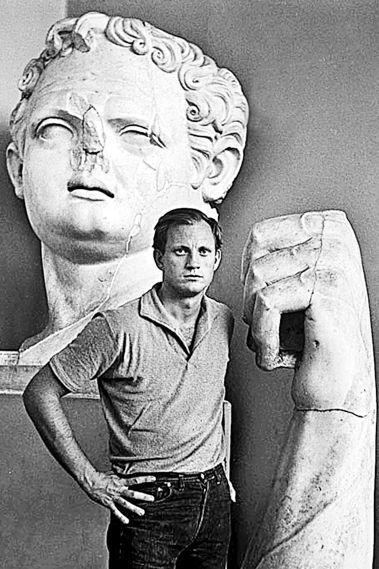Kinmont “KIN” HOITSMA was an American fencer born on this date (d: 2013); Hoitsma competed in the individual and team epée events at the 1956 Summer Olympics. He later became a teacher. He was a long time lover of photographer and designer, Cecil Beaton.
Hoitsma met Beaton in 1963, when the photographer was in Hollywood creating costumes and sets for the film of My Fair Lady. It was an unhappy time for Beaton because he liked to move on swiftly from one project to the next, but on this occasion he was held in Hollywood by contract ; he fell out with the director, George Cukor, and there was a period when the two men refused to speak to one another.
One weekend in March, Beaton escaped to San Francisco, where he wound up at a bar called the Tool Box and met the handsome, 6ft 3in Kin Hoitsma . “His apartment had dried grasses on the windowsill and eight daffodils were very charming in a black pot,” Beaton noted.
An unlikely friendship formed, and soon Beaton was to be found hiking in Big Sur and camping out under the stars in the Yosemite Valley. Hoitsma was able to discuss art, but he had never heard of Chanel — or, for that matter, of Beaton. The relationship was greatly encouraged by Christopher Isherwood , and Truman Capote reportedly told Beaton he had never looked better.
On his return to Britain, Beaton invited Hoitsma to move in with him. Hoitsma arrived in London in June 1964 to study at the Slade and was given modest accommodation at 8 Pelham Place, Beaton’s London home, and the smaller spare room at Reddish House, Broadchalke.
Hoitsma met Princess Margaret and became fond of Pauline de Rothschild and Countess Brandolini. But after a year he told Beaton that he had to leave: he was yearning for the hills around San Francisco. For his part, Beaton, though devoted to Kin, was not cut out for domesticity; but he was still devastated . The two men remained friends to the end.
Kinmont Trefry Hoitsma was born in Cooperstown, New York, the son of Ralph Hoitsma, a salesman in the paper trade, in turn the son of a cattle rancher in Wyoming who had emigrated from Holland.
The family was peripatetic, moving between the East Coast and the Midwest. Kin graduated from Shaker Heights High School in Ohio, and went on to Princeton University where he studied Greek and majored in French.
In 1956 he competed in the Ivy League Fencing Championship, losing narrowly in the final match, against Columbia. He went on to the collegiate finals, and in November that year, aged 22, fenced for the United States at the Melbourne Olympics. The men’s epée team did not make it beyond the first round, though in the individual men’s epée Hoitsma reached the quarter-finals, defeating the eventual gold medallist, Carlo Pavesi.
On his way back from the Games Hoitsma stopped off in San Francisco, and liked it so much that he settled there, studying Architecture at Berkeley before taking a variety of jobs. He then took an Art History degree at San Francisco State University. It was during this period that he met Beaton.
After his return from London, Hoitsma settled back into academic life, contentedly teaching history, literature, philosophy and religion at Chabot Community College for the next 30 years. On one occasion Beaton even dropped in on one of his English Literature classes, and became absorbed watching Hoitsma dashing “from one end to the other of a blackboard – an Olympic athlete of the mind at work”. In 1967 Hoitsma published The Real Mask, a dissertation on Edward Albee’s play Tiny Alice.
Hoitsma lived on Potrero Hill, where he cultivated old-fashioned roses and was visited in 1967 by Christopher Isherwood. In later life he retired to a home in Oakland, California. He died in September 2013.
